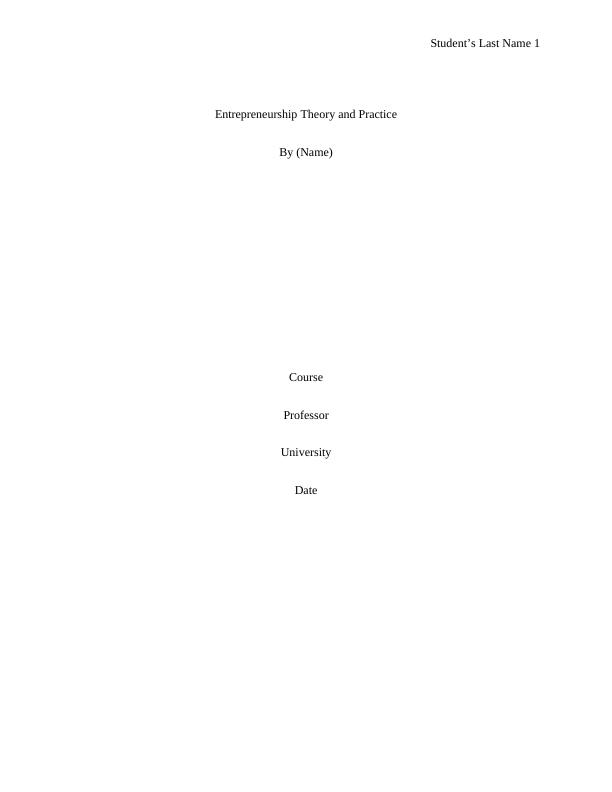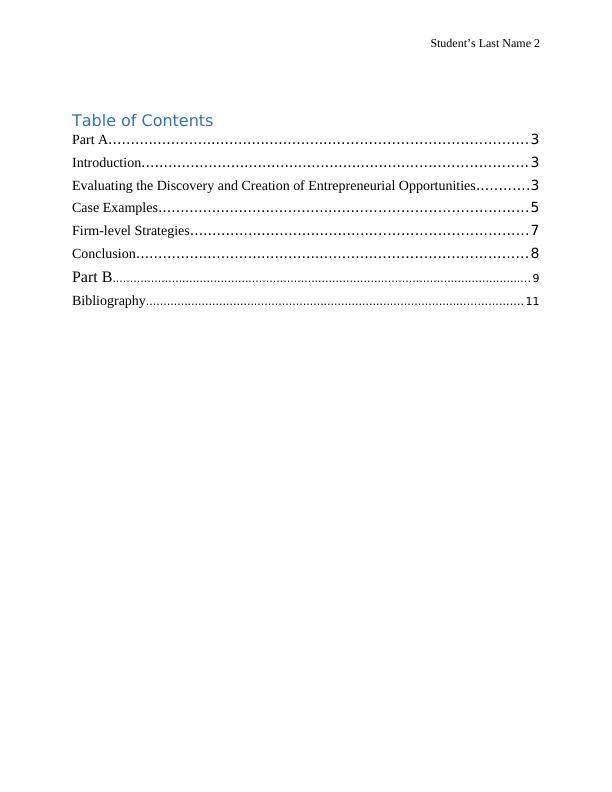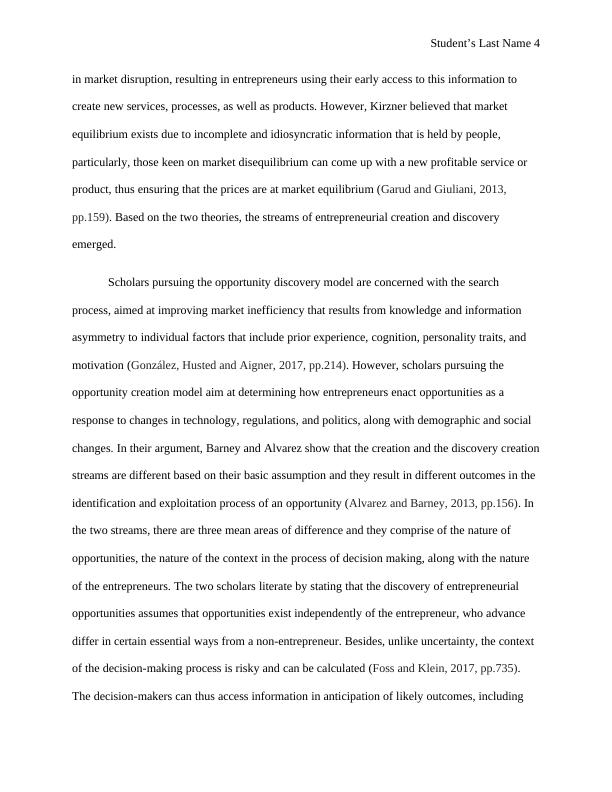Entrepreneurship Theory docx
This is a report style assessment that does not require a case study. Use of relevant examples and illustrations is recommended. Referencing should be done in Harvard style.
13 Pages3082 Words24 Views
Added on 2022-07-28
About This Document
its a report writting
Entrepreneurship Theory docx
This is a report style assessment that does not require a case study. Use of relevant examples and illustrations is recommended. Referencing should be done in Harvard style.
Added on 2022-07-28
ShareRelated Documents
Student’s Last Name 1
Entrepreneurship Theory and Practice
By (Name)
Course
Professor
University
Date
Entrepreneurship Theory and Practice
By (Name)
Course
Professor
University
Date

Student’s Last Name 2
Table of Contents
Part A............................................................................................. 3
Introduction...................................................................................... 3
Evaluating the Discovery and Creation of Entrepreneurial Opportunities............3
Case Examples..................................................................................5
Firm-level Strategies...........................................................................7
Conclusion....................................................................................... 8
Part B........................................................................................................................ 9
Bibliography............................................................................................................ 11
Table of Contents
Part A............................................................................................. 3
Introduction...................................................................................... 3
Evaluating the Discovery and Creation of Entrepreneurial Opportunities............3
Case Examples..................................................................................5
Firm-level Strategies...........................................................................7
Conclusion....................................................................................... 8
Part B........................................................................................................................ 9
Bibliography............................................................................................................ 11

Student’s Last Name 3
Part A
Introduction
An entrepreneurial activity refers to the process of introducing new goods and services,
as well as raw materials, markets, including organizing methods by forming new means and ends
relationships. Despite that the concept of opportunity is crucial to entrepreneurial and economic
theories, the primary source of an opportunity is still an ongoing discussion. One stream of
search debate indicates that the existence of an opportunity is as a result of market equilibrium,
thus resulting in “discovery” by individuals that are alert to opportunities, the other stream
argues that an entrepreneur’s initiative is essential to the emergence of an opportunity. As a
result, the second stream asserts that entrepreneurs “create” the opportunities. Alvarez and
Barney (2013) summarize the fundamental difference that exists between the two streams by
inferring to differing practical implications for each. An entrepreneur’s perceived context, may it
be discovery or creation, determines the efficiency of the actions an entrepreneur takes. The
paper revisits earlier entrepreneurial theories, taking into account the effectuation theory to
evaluate the creation as well as the discovery contexts of entrepreneurial opportunities. Inferring
to cases of disruptive innovation (DI), the paper shows that entrepreneurs act in a manner that
involves discovery as well as the creation of opportunities.
Evaluating the Discovery and Creation of Entrepreneurial Opportunities
The debate as to whether the entrepreneurial opportunity is created or discovered was as a
result of differing between Schumpeter (1934) and Kirzner (1979). According to Schumpeter,
exogenous shocks that comprise of demographic, social, along with technological changes result
Part A
Introduction
An entrepreneurial activity refers to the process of introducing new goods and services,
as well as raw materials, markets, including organizing methods by forming new means and ends
relationships. Despite that the concept of opportunity is crucial to entrepreneurial and economic
theories, the primary source of an opportunity is still an ongoing discussion. One stream of
search debate indicates that the existence of an opportunity is as a result of market equilibrium,
thus resulting in “discovery” by individuals that are alert to opportunities, the other stream
argues that an entrepreneur’s initiative is essential to the emergence of an opportunity. As a
result, the second stream asserts that entrepreneurs “create” the opportunities. Alvarez and
Barney (2013) summarize the fundamental difference that exists between the two streams by
inferring to differing practical implications for each. An entrepreneur’s perceived context, may it
be discovery or creation, determines the efficiency of the actions an entrepreneur takes. The
paper revisits earlier entrepreneurial theories, taking into account the effectuation theory to
evaluate the creation as well as the discovery contexts of entrepreneurial opportunities. Inferring
to cases of disruptive innovation (DI), the paper shows that entrepreneurs act in a manner that
involves discovery as well as the creation of opportunities.
Evaluating the Discovery and Creation of Entrepreneurial Opportunities
The debate as to whether the entrepreneurial opportunity is created or discovered was as a
result of differing between Schumpeter (1934) and Kirzner (1979). According to Schumpeter,
exogenous shocks that comprise of demographic, social, along with technological changes result

Student’s Last Name 4
in market disruption, resulting in entrepreneurs using their early access to this information to
create new services, processes, as well as products. However, Kirzner believed that market
equilibrium exists due to incomplete and idiosyncratic information that is held by people,
particularly, those keen on market disequilibrium can come up with a new profitable service or
product, thus ensuring that the prices are at market equilibrium (Garud and Giuliani, 2013,
pp.159). Based on the two theories, the streams of entrepreneurial creation and discovery
emerged.
Scholars pursuing the opportunity discovery model are concerned with the search
process, aimed at improving market inefficiency that results from knowledge and information
asymmetry to individual factors that include prior experience, cognition, personality traits, and
motivation (González, Husted and Aigner, 2017, pp.214). However, scholars pursuing the
opportunity creation model aim at determining how entrepreneurs enact opportunities as a
response to changes in technology, regulations, and politics, along with demographic and social
changes. In their argument, Barney and Alvarez show that the creation and the discovery creation
streams are different based on their basic assumption and they result in different outcomes in the
identification and exploitation process of an opportunity (Alvarez and Barney, 2013, pp.156). In
the two streams, there are three mean areas of difference and they comprise of the nature of
opportunities, the nature of the context in the process of decision making, along with the nature
of the entrepreneurs. The two scholars literate by stating that the discovery of entrepreneurial
opportunities assumes that opportunities exist independently of the entrepreneur, who advance
differ in certain essential ways from a non-entrepreneur. Besides, unlike uncertainty, the context
of the decision-making process is risky and can be calculated (Foss and Klein, 2017, pp.735).
The decision-makers can thus access information in anticipation of likely outcomes, including
in market disruption, resulting in entrepreneurs using their early access to this information to
create new services, processes, as well as products. However, Kirzner believed that market
equilibrium exists due to incomplete and idiosyncratic information that is held by people,
particularly, those keen on market disequilibrium can come up with a new profitable service or
product, thus ensuring that the prices are at market equilibrium (Garud and Giuliani, 2013,
pp.159). Based on the two theories, the streams of entrepreneurial creation and discovery
emerged.
Scholars pursuing the opportunity discovery model are concerned with the search
process, aimed at improving market inefficiency that results from knowledge and information
asymmetry to individual factors that include prior experience, cognition, personality traits, and
motivation (González, Husted and Aigner, 2017, pp.214). However, scholars pursuing the
opportunity creation model aim at determining how entrepreneurs enact opportunities as a
response to changes in technology, regulations, and politics, along with demographic and social
changes. In their argument, Barney and Alvarez show that the creation and the discovery creation
streams are different based on their basic assumption and they result in different outcomes in the
identification and exploitation process of an opportunity (Alvarez and Barney, 2013, pp.156). In
the two streams, there are three mean areas of difference and they comprise of the nature of
opportunities, the nature of the context in the process of decision making, along with the nature
of the entrepreneurs. The two scholars literate by stating that the discovery of entrepreneurial
opportunities assumes that opportunities exist independently of the entrepreneur, who advance
differ in certain essential ways from a non-entrepreneur. Besides, unlike uncertainty, the context
of the decision-making process is risky and can be calculated (Foss and Klein, 2017, pp.735).
The decision-makers can thus access information in anticipation of likely outcomes, including

End of preview
Want to access all the pages? Upload your documents or become a member.
Related Documents
Entrepreneurship Theory and Practicelg...
|10
|2526
|438
Understanding and Leading Changelg...
|11
|563
|70
Entrepreneurship Research Paper 2022lg...
|9
|2273
|20
